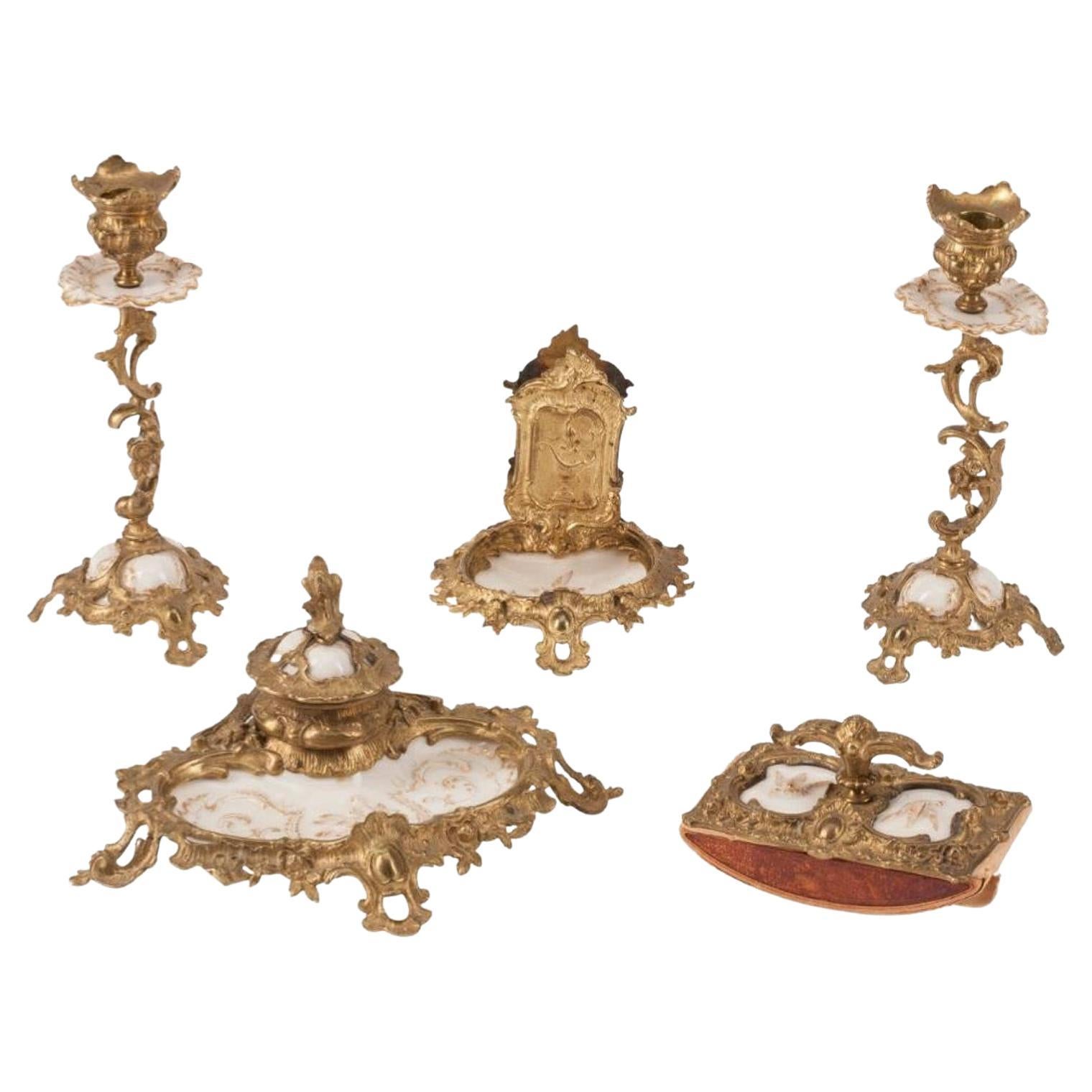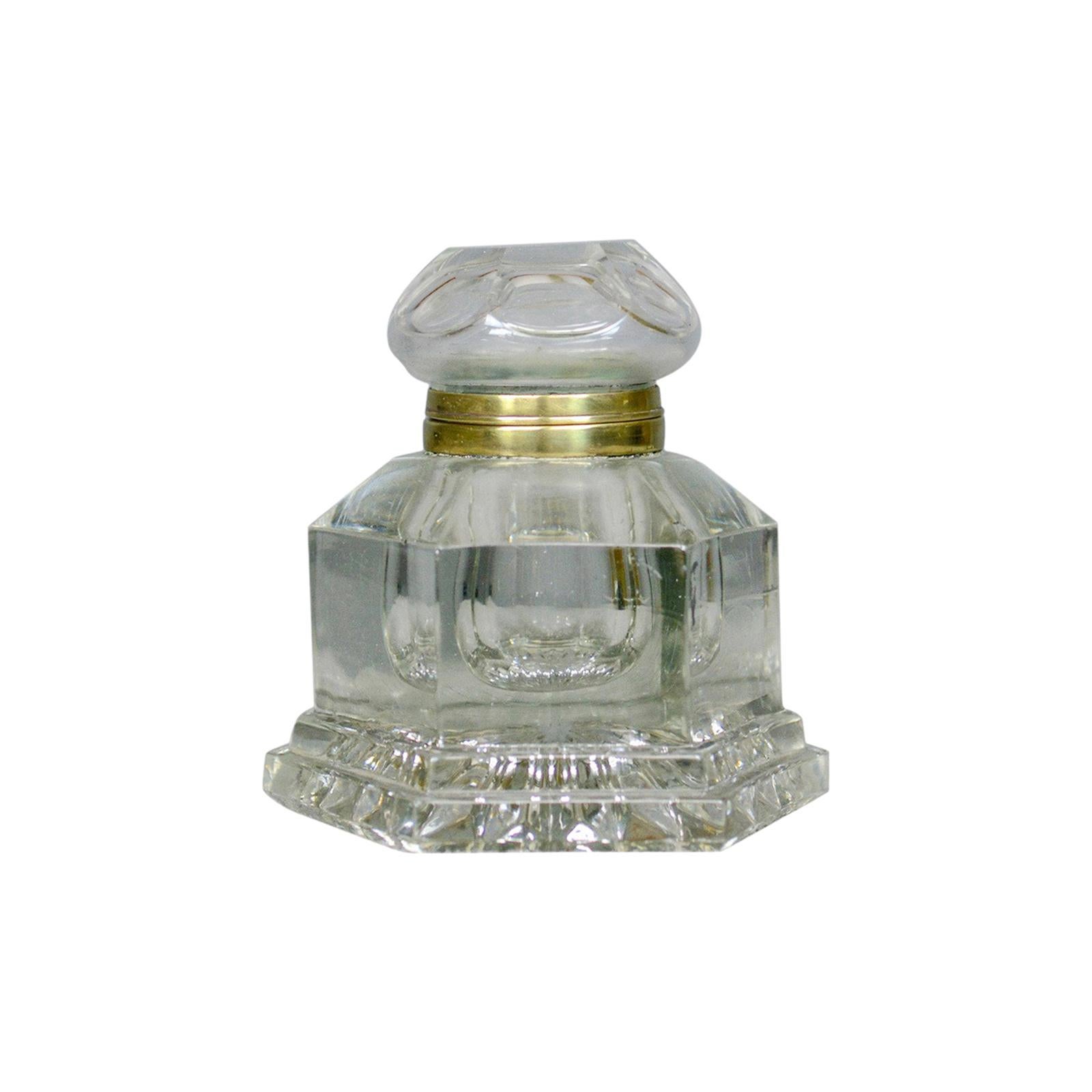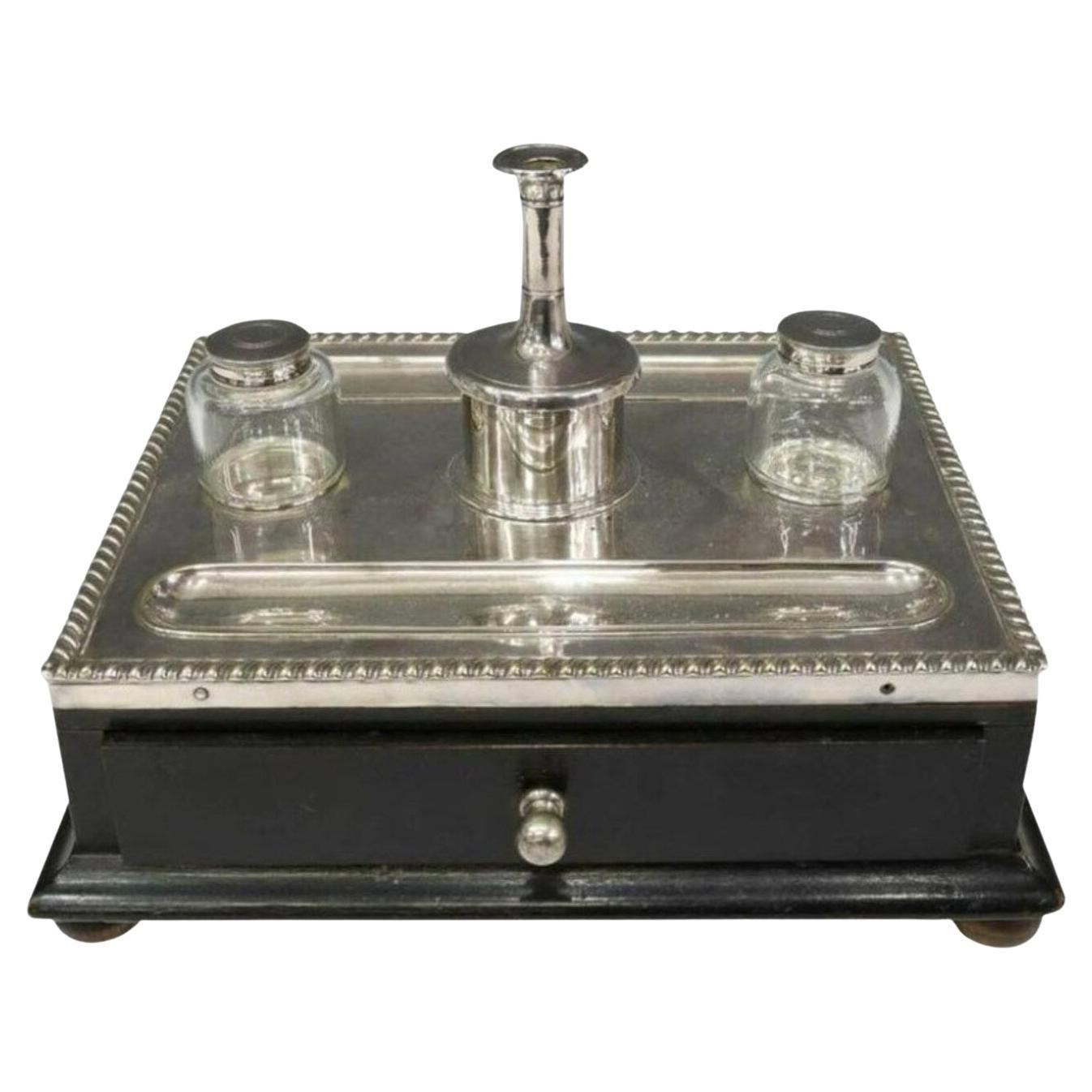Items Similar to Antique English Coromandel & Ormolu Mounted Four Piece Desk Set Mid 19th C
Want more images or videos?
Request additional images or videos from the seller
1 of 21
Antique English Coromandel & Ormolu Mounted Four Piece Desk Set Mid 19th C
About the Item
This is a wonderful and highly decorative antique Victorian ormolu mounted coromandel four piece desk set by the renowned London maker of luxury items, Betjemann & Sons, cira 1860 in date,
The set features gothic style mounts enclosing porcelain medallions decorated with cherubs, comprising a dome topped casket, an adjustable bookrest, a circular cut glass inkwell and a blotter.
There is no mistaking its unique quality and design, which is sure to make it a treasured piece by any discerning collector.
Condition:
In excellent condition having been beautifully restored in our workshops, please see photos for confirmation.
Dimensions in cm:
Height 2 x Width 18 x Depth 41 - Blotter
Dimensions in inches:
Height 1 inch x Width 7 inches x Depth 1 foot, 4 inches - Blotter
Betjemann & Sons
In 1812 George Betjemann started apprenticing as a cabinet maker with his uncle, Gilbert Slater at his premises on Carthusian Street, London. In 1834, George then joined his father-in-law, William Merrick’s cabinet making business on Red Lion Street, Clerkenwell, London. George brought his sons, George William Betjemann and John Betjemann to apprentice with him from 1848. He began his own business at 6 Upper Ashby Street, Clerkenwell, London, and with his two sons having completed their apprenticeships in 1855, expanded to 7 Upper Ashby Street shortly after.
In 1859, George moved into 36 Pentonville Road, London where he continued his business, now called George Betjemann & Sons, alongside his two sons. George William never married but instead was ‘married’ to his work, being a true artist and perfectionist. Their work was on display at the International Exhibition of 1862, and the International Exposition of 1867 in Paris. They took the art of cabinet, box and book slide making to new heights. They specialised in designs for operating the way that different compartments in vanity boxes opened and also the sprung system for book slides.
By 1871, they had expanded their residence to incorporate 38 Pentonville Road and were employing 119 people. Records show that by 1875 a further incorporation of 40 Pentonville Road was undertaken. George died in 1886 at the age of 88 and George William and John ran George Betjemann & Sons in partnership until John’s death in 1893. George William then established a business partnership with John’s sons, John George Betjemann and Ernest Edward Betjemann. Around 1896, John George and Ernest Edward established an offshoot company called Betjemann Brothers, based at 2 Newcastle Place, Clerkenwell, London. This company ran alongside George Betjemann & Sons until they were merged in 1903, following the death of George William. In 1909, they became a limited company, known as George Betjemann & Sons Ltd.
With Ernest’s son John (the future poet Sir John Betjeman) having no interest in carrying on the family business, George Betjemann & Sons Ltd finally wound up in 1939.
Coromandel wood or Calamander wood
is a valuable wood from India, Sri Lanka and South East Asia. It is of a hazel-brown color, with black stripes (or the other way about), very heavy and hard. It is also known as Macassar Ebony or variegated ebony and is closely related to genuine ebony, but is obtained from different species in the same genus; one of these is Diospyros quaesita Thwaites, from Sri Lanka. The name Calamander comes from the local sinhalese name, 'kalu-medhiriya', which means dark chamber; referring to the characteristic ebony black wood.
Coromandel wood has been logged to extinction over the last 2 to 3 hundred years and is no longer available for new work in any quantity. Furniture in coromandel is so expensive and so well looked after that even recycling it is an unlikely source. A substitute, Macassar Ebony, has similar characteristics and to the untrained eye is nearly the same but it lacks the depth of colour seen in genuine Coromandel.
Ormolu - Gilt Bronze (from French 'or moulu', signifying ground or pounded gold) is an 18th-century English term for applying finely ground, high-carat gold in a mercury amalgam to an object of bronze.The mercury is driven off in a kiln leaving behind a gold-coloured veneer known as 'gilt bronze'.
The manufacture of true ormolu employs a process known as mercury-gilding or fire-gilding, in which a solution of nitrate of mercury is applied to a piece of copper, brass, or bronze, followed by the application of an amalgam of gold and mercury. The item was then exposed to extreme heat until the mercury burned off and the gold remained, adhered to the metal object.
Our reference: A3074x
- Creator:George Betjemann & Sons (Maker)
- Dimensions:Height: 0.79 in (2 cm)Width: 7.09 in (18 cm)Depth: 16.15 in (41 cm)
- Sold As:Set of 4
- Style:Victorian (Of the Period)
- Materials and Techniques:
- Place of Origin:
- Period:
- Date of Manufacture:circa 1860
- Condition:
- Seller Location:London, GB
- Reference Number:
About the Seller
5.0
Platinum Seller
These expertly vetted sellers are 1stDibs' most experienced sellers and are rated highest by our customers.
Established in 1983
1stDibs seller since 2012
1,199 sales on 1stDibs
Typical response time: 1 hour
Associations
LAPADA - The Association of Arts & Antiques Dealers
- ShippingRetrieving quote...Ships From: London, United Kingdom
- Return PolicyA return for this item may be initiated within 14 days of delivery.
More From This SellerView All
- 19th Century Victorian Malachite and Ormolu-Mounted InkwellLocated in London, GBThis is a wonderful antique Victorian ormolu and malachite mounted inkwell, circa 1870 in date. The ormolu inkwell has a decorative inset turquoise cabochon gemstone with a chain ...Category
Antique 1870s English Victorian Inkwells
MaterialsMalachite, Ormolu
- Antique Regency Campaign Writing Slope Brass Mounts, 19th CenturyLocated in London, GBAn elegant Regency brass mounted Gonçalo Alves campaign writing slope, circa 1820 in date. The beautifully polished goncalo alves case has a ...Category
Antique 1820s Regency Desk Sets
MaterialsWood
- Antique French Empire Revival Ormolu Mounted Desk, 19th CenturyLocated in London, GBThis is an exquisite French Empire Revival pedestal desk, circa 1880 in date. This desk has been beautifully crafted from flame mahogany. The top has a striking gold tooled black leather inset writing surface which has a decorative geometric inlaid satinwood and ebony border around it. It features beautifully cast gilded Ormolu mounts including angels, pharaonic herms above paw feet and swan escutcheons. It is further enhanced with male masks wearing nemes headress's on the sides, making it an incredibly imposing and impressive item of furniture. The desk features seven drawers for maximum storage, it is freestanding with a beautifully panelled back and comes complete with the original working locks and keys. This desk will soon become the centrepiece of your furniture collection, there is no mistaking the sophisticated quality and design and it is certain to enhance the style and elegance of any living area, bedroom, or reception. THE BOTANICAL NAME FOR THE MAHOGANY THIS ITEM IS MADE OF IS SWIETENIA MACROPHYLLA AND THIS TYPE OF MAHOGANY IS NOT SUBJECT TO CITES REGULATION. Condition: In excellent condition having been beautifully cleaned, French polished, waxed and releathered in our workshops, please see photos for confirmation. Dimensions in cm: Height 76 x width 150 x depth 80 Dimensions in inches: Height 29.9 x width 59.1 x depth 31.5 Empire style, is an early 19th century design movement in architecture, furniture, other decorative arts, and the visual arts followed in Europe and America until circa 1830. The style originated in and takes its name from the rule of Napoleon I in the First French Empire, where it was intended to idealize Napoleon's leadership and the French state. The style corresponds to the Biedermeier style in the German-speaking lands, Federal style in the United States and to the Regency style in Britain. The previous style was called Louis XVI style, in France. The Empire style was based on aspects of the Roman Empire. It is the second phase of neoclassicism which is also called "Directoire", after a government system. Furniture typically had symbols and ornaments borrowed from the glorious ancient Greek and Roman empires. The furniture was made from heavy woods such as mahogany and ebony, imported from the colonies, with dark finishes often with decorative bronze mounts. Marble tops were popular as were Egyptian motifs like sphinxes, griffins, urns and eagles and the Napoleonic symbols, the eagle, the bee, the initials "I" and a large "N." Gilded bronze (ormolu) details displayed a high level of craftsmanship. Flame mahogany Thomas Sheraton - 18th century furniture designer, once characterized mahogany as "best suited to furniture where strength is demanded as well as a wood that works...Category
Antique 1880s French Empire Revival Desks and Writing Tables
MaterialsOrmolu
- Antique Louis Revival Ormolu Mounted Bureau Plat Desk 19th CLocated in London, GBThis is a gorgeous antique French Louis Revival gilt bronze mounted amaranth bureau plat, Circa 1860 in date. The shaped top has a decorative gil...Category
Antique 1860s French Desks and Writing Tables
MaterialsOrmolu
- Antique Grand Tour Italian Vatican Micro-Mosaic Marble Desk Weight 19th CenturyLocated in London, GBThis is a stunning decorative antique Italian Grand Tour Vatican Micro-Mosaic inset black marble desk weight, in the form of a miniature table, circa 1870 ...Category
Antique 1870s Italian Paperweights
MaterialsAgate, Malachite, Onyx, Granite, Marble, Porphyry
- Antique Victorian Ashford Pietra Dura Marble Obelisk, 19th CenturyLocated in London, GBThis is a wonderful Derbyshire Ashford pietra dura obelisk, inlaid with lillies, circa 1880 in date. The obelisk is beautifully inlaid with a Pi...Category
Antique 1880s English Victorian More Desk Accessories
MaterialsMarble, Malachite
You May Also Like
- Fine 19th Century Ormolu Mounted KPM Porcelain Desk Set - Inkwell CandlesticksBy Berlin Royal Porcelain FactoryLocated in Forney, TXA very fine quality, exquisitely hand-crafted, late nineteenth century bronze doré mounted Royal Porcelain Factory Berlin (KPM) porcelain five piece desk set. The breathtaking anti...Category
Antique Late 19th Century Louis XV Desk Sets
MaterialsBronze
- 19th Century Ormolu and Mahogany Desk SetLocated in Martlesham, GBA lovely 19th Century French ormolu and mahogany desk set on ormolu claw feet, there are two ink well holders and a pen holder, in the centre is a carv...Category
Antique 1820s French Desk Sets
MaterialsOrmolu
- Large Antique Ink Well, English, Crystal Glass, Desk, Mid-19th CenturyLocated in Hele, Devon, GBThis is a large antique ink well. An English, crystal glass, desk ink well dating to the mid-19th century, circa 1850. Larger than most at 13 cm, 5 i...Category
Antique Mid-19th Century English Early Victorian Inkwells
MaterialsCut Glass
- Antique English Coromandel Bronze Mounted Book HolderLocated in New Orleans, LAThis is a rare and striking little book holder, with beautiful coromandel wood and brass mounts. It is a treasure awaiting your purchase to house some favorites in your book collecti...Category
Antique Late 19th Century European Bookcases
MaterialsBronze
- 19th Century Victorian English Double Inkwell Desk SetLocated in Forney, TXA charming Victorian era English silver plate desk stand, born in the late 19th century, having two glass inkwell pots, candlestick, recessed pen wells, gadrooned border, ebonized ca...Category
Antique Late 19th Century Victorian Desk Sets
MaterialsSilver Plate
- 19th Century English Desk BoxLocated in Los Angeles, CAEnglish early 19th-century dark wooden desk box. Featuring a thin wide drawer with bead-shaped brass pull, four upper compartments of various sizes an...Category
Antique 1830s English William IV More Desk Accessories
MaterialsWood





